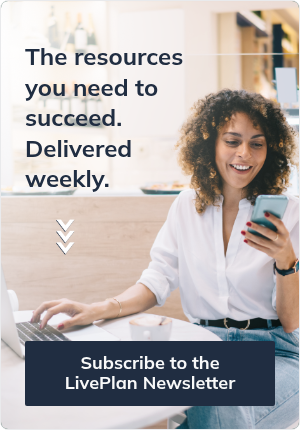Ready to take your financial planning to the next level? This webinar, led by LivePlan's product engagement expert Lauren McColl, customer success specialist Julia Clark, and assisted by Annie from the support team, reveals how to seamlessly integrate your existing accounting data to create a robust and actionable forecast. Learn how to transform raw financial information into a clear roadmap for your business, empowering you to make informed decisions and achieve your goals. Watch now and gain the clarity you need to navigate your business's future with confidence!
What You'll Learn
This webinar is packed with practical tips and answers to the most common questions from our partner community. Here’s a look at what we cover:
Connect Your Accounting Solution: Discover how to link LivePlan directly to QuickBooks Online or Xero for effortless data import, laying the foundation for an accurate forecast. Rapid Forecast Creation with the New Builder: Explore the brand-new forecast builder, a powerful tool that automatically organizes your accounting data into a useful and intuitive forecast, saving you valuable time. Customize Your Starting Forecast: Learn to adjust and refine your initial forecast to truly reflect your business goals, ensuring it serves as a dynamic roadmap for decision-making. Strategic Forecasting for Decision Making: Understand how your well-structured forecast acts as a vital tool for strategic planning, providing clear insights into future profit, cash flow, and growth opportunities. Leverage LivePlan's Support Resources: Get acquainted with LivePlan's extensive help center and expert customer advocate team, ensuring you have continuous support for your forecasting journey.
Getting Started with the Forecast Builder
Initial Setup and Overview: See a completed starting forecast derived from QuickBooks data and understand how actuals and previous fiscal year data are populated. Adjusting Forecast Preferences: Learn where to modify your fiscal year, forecast start date, and forecast length to align with your business's financial calendar. Connecting Your Accounting Software: A step-by-step guide on connecting LivePlan to QuickBooks Online or Xero, or opting for manual data entry if preferred. Navigating the Forecast Builder: Understand the initial message and the core steps involved in transforming your accounting data into a LivePlan forecast.
Tailoring Your Revenue & Expenses
Streamline Revenue Categories: Learn to customize suggested revenue streams by renaming, moving, combining, or excluding QuickBooks accounts, allowing you to prioritize key performance indicators. Consolidate for Clarity: Combine multiple QuickBooks accounts into single, meaningful LivePlan revenue categories, simplifying your forecast without altering your QuickBooks chart of accounts. Exclude Irrelevant Accounts: Efficiently remove accounts that do not need to be tracked in LivePlan, maintaining focus on essential data. Create New Revenue Streams: Add custom revenue streams to track new initiatives or specific areas of growth.
Optimize Special Expenses: Accurately categorize payroll, income taxes, and interest expenses by confirming the relevant QuickBooks accounts, ensuring these critical financial components are correctly represented. Group Similar Expenses: Combine related operating expenses (e.g., electricity, internet, phone into "Utilities") to simplify your forecast and highlight significant spending areas.
Refining Your Forecast for Accuracy
Verify Starting Balances: Review and adjust automatically populated starting balances from your balance sheet to ensure an accurate initial cash position and other financial accounts. Incorporate Financing Details: Manually add existing loans and lines of credit, including custom repayment terms or grace periods, to accurately reflect your debt obligations and cash flow. Configure Tax Rates: Input your specific income tax and sales tax rates to ensure accurate tax calculations within your forecast. Set Cash Flow Assumptions: Define assumptions for accounts receivable, accounts payable, and inventory to refine your cash flow projections and balance sheet accuracy.
Advanced Forecasting Tools
Utilize Forecast Notes: Add detailed notes to specific forecast items or cells to document assumptions, explain changes, and facilitate collaboration with team members or advisors. Leverage Scenarios for Strategic Planning: Create multiple forecast scenarios (e.g., best-case, worst-case, new product launch) by copying your working forecast to test different assumptions without impacting your core plan. Analyze Performance with LiveForecast: Use the LiveForecast feature on your Profit and Loss statement to compare actual performance against your forecast, identifying variances and opportunities for adjustment. Deep Dive with the Dashboard: Explore the LivePlan dashboard for in-depth data comparison, trend analysis, and comprehensive insights into your business's financial health over time.



